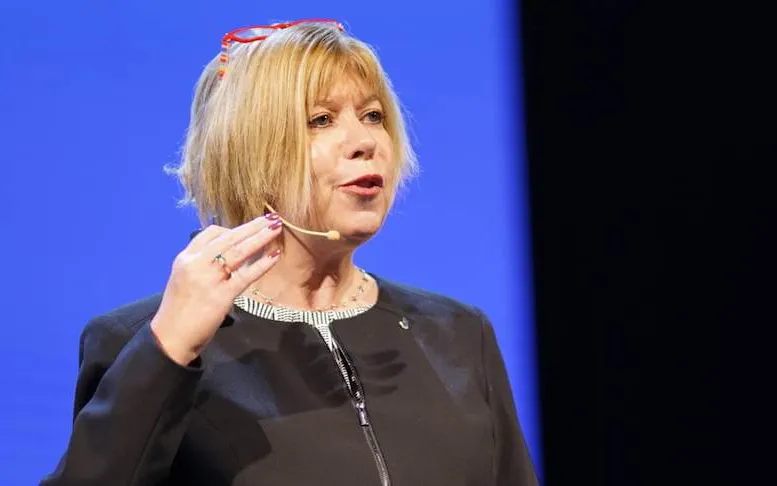Karen Horting: "Almost 40% of female engineers leave the engineering workforce by midcareer"
Karen Horting, CEO and Executive Director, shares the aims of the Society of Women Engineers to "empower women to achieve their full potential in careers as engineers and leaders".
The Society of Women Engineers (SWE), founded in 1950, aims to empower women to achieve their full potential in engineering careers, advocate for gender diversity and inclusion, and promote the positive impact of engineering on quality of life. SWE supports women engineers through professional development programs, networking opportunities, mentoring, and leadership initiatives. Their advocacy efforts focus on policy changes for STEM education and gender equity, while initiatives like SWENext engage young girls in STEM. SWE's annual WE Conference is a significant event for professional growth and networking. Despite progress, SWE continues to address ongoing challenges such as implicit bias and aims to expand its global presence and partnerships to further its mission.
Can you tell us about the history and mission of the Society of Women Engineers (SWE)?
The Society was founded in 1950 by women engineers who did not feel that their needs were being met by the other discipline-focused engineering societies, and they wanted women to have a voice within the profession. For almost 75 years, SWE has given women engineers a unique place and voice within the engineering industry. Our organization is centered around a passion for our members’ success and continues to evolve with the challenges and opportunities reflected in today’s exciting engineering and technology specialties.
Our mission: Empower women to achieve their full potential in careers as engineers and leaders; expand the image of the engineering and technology professions as a positive force in improving the quality of life, and demonstrate the value of diversity and inclusion.
How does SWE support the professional and personal development of women in engineering?
All of our programming and offerings empower women to succeed at every stage of their personal development and professional careers. We support the recruitment, retention, and advancement of women in engineering through career resources, professional development, and one-on-one networking opportunities through live and online learning, including SWE’s Advance Learning Center, CEU/PDH offerings, and leadership programs like ALWE (Academic Leadership for Women in Engineering), CLI (Collegiate Leadership Institute), and eXXec (SWE Executive Leadership Prgram). Moreover, our virtual mentoring platform provides members the opportunity to connect with mentors around the globe from all engineering and technology displines and all career stages.
Perhaps the most powerful way our members leverage SWE in their personal and professional growth is through our worldwide community of 47,000+ women engineers and allies. The connections they make have transformed their trajectory and have formed lifelong friends and mentors.
What are some of the key initiatives SWE has launched to promote diversity, equity, and inclusion in engineering?
Our newest initiative is Advocates for Empowerment (A4E), a gender parity and equality corporate recognition and benchmarking program offered annually by the Society of Women Engineers. A4E seeks to identify and publicly recognize organizations that are great places to work for diverse women in engineering and technology, and encourage other organizations to adopt policies, practices, and a workplace culture that supports parity and equality.
SWE A4E uses rigorous methodology to analyze data from participating companies to identify the best employers and provide actionable information and insights to both companies and women in engineering and technology.
Can you describe the impact of SWE’s advocacy efforts on policies related to STEM education and gender equity in the workplace?
Our initiatives support the Society’s mission by engaging our members and local and federal representatives in policy issues that impact the advancement of women in engineering. We provide SWE members and representatives at all levels of government with timely information and tools to enhance their understanding of the issues. We also encourage volunteer participation from our members at the federal level for our annual Congressional visits where we focus on issues like gender equity in STEM education and the STEM workforce, paycheck fairness, and adequate funding of STEM education. Currently, our advocacy efforts are focused on the STEM Restart Act. SWE helped draft this legislation that is focused on bringing women back to STEM workforce after a career break. The legislation provides tax incentives to both small and midsize businesses and those in rural areas who launch reentry programs.
How does SWE engage with young girls and encourage them to pursue careers in engineering through programs like SWENext?
SWE takes a holistic approach to women in engineering, from pre-college through retirement. The SWENext program inspires creativity and curiosity in science, technology, engineering, and math (STEM) and shows pre-college kids how a career in STEM can become a reality. Participants in this free program enjoy numerous opportunities throughout the year to learn, network, and connect with peers, role models, and industry professionals. Plus, this diverse, welcoming, pre-college STEM community provides a safe place where young women can feel seen, heard, and validated. It is where they can develop their STEM identity and picture themselves in careers as engineers and technologists.
How does SWE's annual WE Conference contribute to the professional growth of women engineers?
The WE conference is the world’s largest conference for women in engineering and technology. During this three-day event, participants can network and attend our signature career fair – the biggest for women in engineering and technology –offering opportunities for internships and full-time postitions at all career stages – with many employers extending offers on the spot. There are also hundreds of interactive workshops, keynotes, and panels where attendees learn from industry leaders and subject matter experts. And the opportunities to network and connect with others in the field are limitless!
What are some of the challenges women in engineering still face today, and how is SWE addressing these issues?
Gender and racial bias in engineering has a significant impact on the retention of diverse talent. Research studies indicate that almost 40% of female engineers leave the engineering workforce by midcareer. Implicit or unconscious bias can have a negative impact on the workplace climate, affecting decisions in hiring, promotions, and compensation for women and other underrepresented minorities in engineering and keeping them from reaching senior-level and leadership positions.
In partnership with the Center for WorkLife Law at the University of California, Hastings College of Law, SWE conducted a study to understand engineers’ experiences with implicit bias in the workplace. Over 3,000 male and female professionals with at least two years of experience as engineers or engineering technicians participated. The results of the study suggest that workplace climate is tougher for women and people of color as compared with white men. The full report can be found here.
How can individuals and organizations get involved with or support the initiatives of SWE?
For individuals, we encourage you to join our global community of 47,000+ women engineers and allies, spanning more than 85 countries worldwide. SWE membership is open to all genders. For employers, they have many avenues to engage and support our efforts, including supporting critical outreach programs and initiatives that reinforce diversity programming to aid the recruitment, advancement and success of women engineers. Participation on SWE’s corporate councils, sponsorship of scholarships, exhibiting at conferences, or posting to our online career center are just a few examples. Details on all our membership and partnership opportunities can be found at www.swe.org.
How does SWE measure and celebrate the achievements of women engineers through its awards program?
The Society of Women Engineers Awards program strives to advance and honor the contributions of women at all stages of their careers, as well as recognize the successes of SWE members, individuals, allies, and employers who enhance the engineering profession through contributions to industry, education, and the community.
The program recognizes those very early in their career, those at mid-career and those at the pinnacle of their career. We prominently feature our award recipients in our SWE Magazine, on our website, and at our annual WE Conference. Awards and recognition are also provided to those in our pre-college SWENext program to further inspire and motivate young girls to pursue an education and career in the industry.
What future goals and projects does SWE have planned to continue advancing the role of women in engineering?
This year’s theme for our annual conference is “Together, We Rise,” and that sentiment speaks to the backbone behind our continued success and growth strategy. We are humbled that membership in SWE continues to increase, which speaks to the ongoing need for support, resources, advocacy, and guidance for women in STEM across the globe. As much progress as we have realized, there is still so much work to be done. Of course, we will continue to build and enhance our offerings and adapt to the ever-changing environment.
The power of SWE, however, lies in our people, our community. That’s why we are always expanding our global footprint — in our existing regions, like India and Europe, and even establishing our presence in others as we did recently in Brazil. Plus, having employer partners who support and promote our mission is invaluable as it enables us to do the work that we do and helps amplify our message and efforts. So, we are always looking to grow those relationships with existing partners and establish new ones. We are far greater than the sum of our parts.




Add new comment